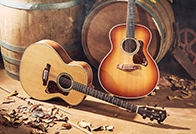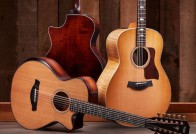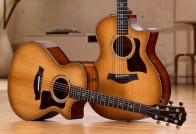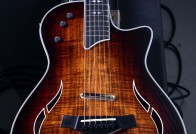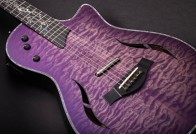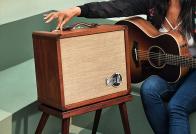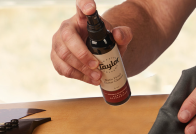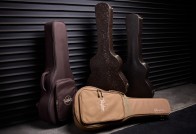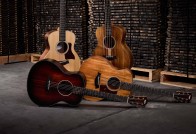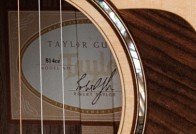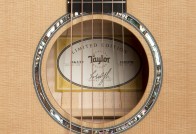The musical bond we form with a guitar often begins with the handfeel — the unique tactile sensation of the instrument in our hands as we play. How the strings respond to our touch, and how we respond to what the guitar gives us back, create the basis for how we express ourselves musically.
Though this might seem like an obvious truth, a closer look at idea of handfeel actually reveals an array of design nuances that contribute to the overall feel and response of a guitar. Ultimately, the characteristics that define a guitar’s handfeel can also inform the styles of music people choose to play on it, as Taylor’s chief guitar designer, Andy Powers, explains.
“For certain playing styles and guitar designs, I like to feel a little resistance, some string tension, in my fretting hand,” he says. “It feels bold and strong. At the same time, on those guitars, usually I like to feel some pushback on my picking hand, because it feels like I can put some muscle behind the pick. Our 25-1/2-inch-scale Grand Pacific is cool for that reason. If I’m playing some bluegrass or a rhythm style where I really want to drive the strings hard, I feel like I can put some muscle into it with both hands and have the guitar respond with muscle of its own. It won’t back down.”
In other cases, Andy says, he might prefer a handfeel that’s slinkier or more touch-sensitive.
“On a 12-fret Grand Concert, I love how loose the strings feel in both of my hands because I’ll probably play that instrument with more finesse,” he explains. “That seems appropriate for the type of voice that guitar has.”
For most Taylor players, the first impression of handfeel is the playability that comes from our sleek neck profile and comfortably low action up the fretboard. Other design factors also affect the string tension and overall playing experience, like the neck angle, fretboard radius, scale length, neck-to-body orientation (12-fret versus 14-fret), string break angle, and string gauge.
We thought we’d take a closer look at some of these individual design attributes and share how they contribute to the handfeel of a Taylor guitar. Hopefully this information will help you differentiate between models in the Taylor line and home in on the kind of handfeel that’s most suitable for your hands and playing preferences.
Neck Profile
This refers to the shape of the back of the neck in relation to its width. When Bob Taylor first introduced Taylor’s slimmer-profile necks, they stood in stark contrast to those of other 6 string acoustic guitars, which featured thicker, deeper dimensions in proportion to their width — a traditional aesthetic that traced back to the guitar’s outgrowth from the mandolin family. Those neck designs evolved in different ways on flattop steel-strings, from more of a V-shaped profile (which made sense on a mandolin) to a rounder profile as steel-string guitars were influenced by both nylon-string guitars and banjos. Still, the necks of the early ’70s were cumbersome for a lot of playing styles, for people with small hands or short fingers, and for electric players, who turned out to be some of Taylor’s early customers.
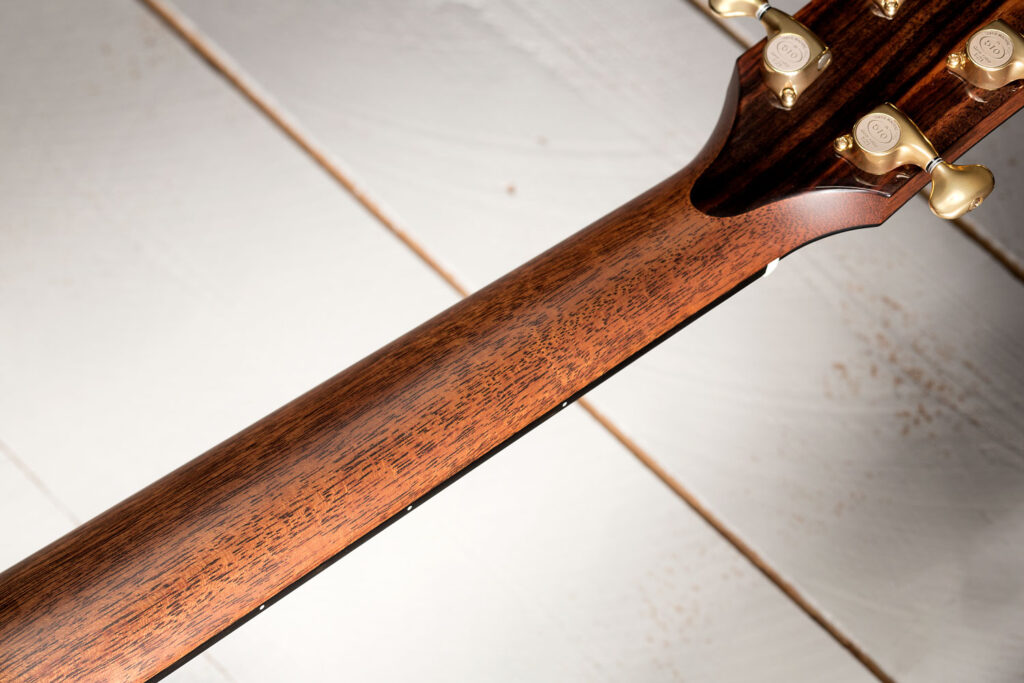
“If you were a player trying to do more lead work or if you were used to playing an electric guitar and trying to translate some of your electric repertoire to an acoustic, Taylor offered a very approachable kind of a neck shape,” Andy says. “It was an acoustic guitar that an electric player could play.”
Currently, Taylor’s standard neck profile would be classified as round, which fits most people well.
“When you compare the width to the depth, it’s not a deep neck — measuring the depth from the very center, in between the D and G strings, to the apex of the arc on the back side — and it doesn’t grow much in thickness as you get towards the body,” Andy says. “It’s a relatively consistent profile along the whole fingerboard. This shape is very approachable for a lot of different playing styles. Whether a player has big hands or small hands will change where their thumb sits on the profile, whether they wrap it over the edge of the fingerboard, whether they’re playing with their thumb in the middle of the back of the neck, or somewhere in between.”
For players who want a thinner neck profile, we also offer a slim-carve option through our Custom guitar program.
“It’s still very round, but it’s basically so thin in relation to its width that the profile feels a little flatter in your hand,” Andy says. “Your thumb is getting close to your fingertips at that point. Some players love that feel.”
The neck profile on our T5z is somewhere between our standard and slim-carve profiles.
And with certain models in Taylor’s Builder’s Edition collection, Andy has designed other premium contouring features associated with the neck, such as the rolled fretboard edges and a compound-carve neck featured on the Builder’s Edition 517e and 717e.
Neck Width
A related component of the neck profile and another important element of a guitar’s handfeel, the neck width (measured at the guitar’s nut) will determine the string spacing and impact the fretting experience for players. Taylor’s standard neck width for its guitars early on was 1-11/16 inches (43 mm), which was the most common neck width for acoustic guitars, although as Bob Taylor has noted, there were also guitars on the market with a 1-5/8-inch (41.2 mm) width. With the resurgence of solo acoustic fingerstyle guitar in the ’80s and ’90s, Taylor started offering a slightly wider 1-3/4-inch (44.5 mm) neck to give players more room for their fretting adventures. Due to its popularity, eventually it became our standard neck width.
With the arrival of the more compact Baby Taylor, a 1-11/16-inch neck width was chosen to suit its scaled-down size and to make it comfortable for the smaller hands of kids. As Taylor’s other layered-wood guitar series were born, including the 100, 200 and Academy Series, plus the GS Mini, we kept that nut width, because, as Bob noted, many guitars in the world still are probably closer to that, being just a little smaller. We didn’t want to force people into the wider neck knowing that these series are often bought by people with less playing experience. At that level, the slightly narrower neck makes forming barre chords a bit easier.
Taylor nylon-string models feature a 1-7/8-inch neck to make them a comfortable crossover for steel-string players (traditional classical guitars usually have a neck width of two or more inches). The slightly wider width compared to our steel-strings is necessary to enable enough space for clean fretting due to the slightly thicker diameter of the nylon strings, as well as their tendency to roll around under the player’s fingertips. Likewise, our 12-string models feature a 1-7/8-inch neck to accommodate the additional strings.

Action
For most players, action refers to the distance between the strings and the fretboard. Low action, which our guitars are known for having, means the strings are closer the fretboard, making it easier to form chords. But Andy points out that the size of the frets is also a contributing factor.
“What I consider the action to be is actually the measurement from the bottom of the string at rest to the tops of the frets, not to the fingerboard wood,” he explains. “The string doesn’t hit the fingerboard like on a violin; it hits the top of the frets. Complicating matters even more, what our fingertips feel is the distance from the top of the string to the fingerboard wood. That’s what we actually press down; it’s a different dimension. You can have really tall frets and very low action and still feel like the strings are a mile away from the fingerboard. That’s a distinctly different playing feel than if you have tiny little frets with low action.”
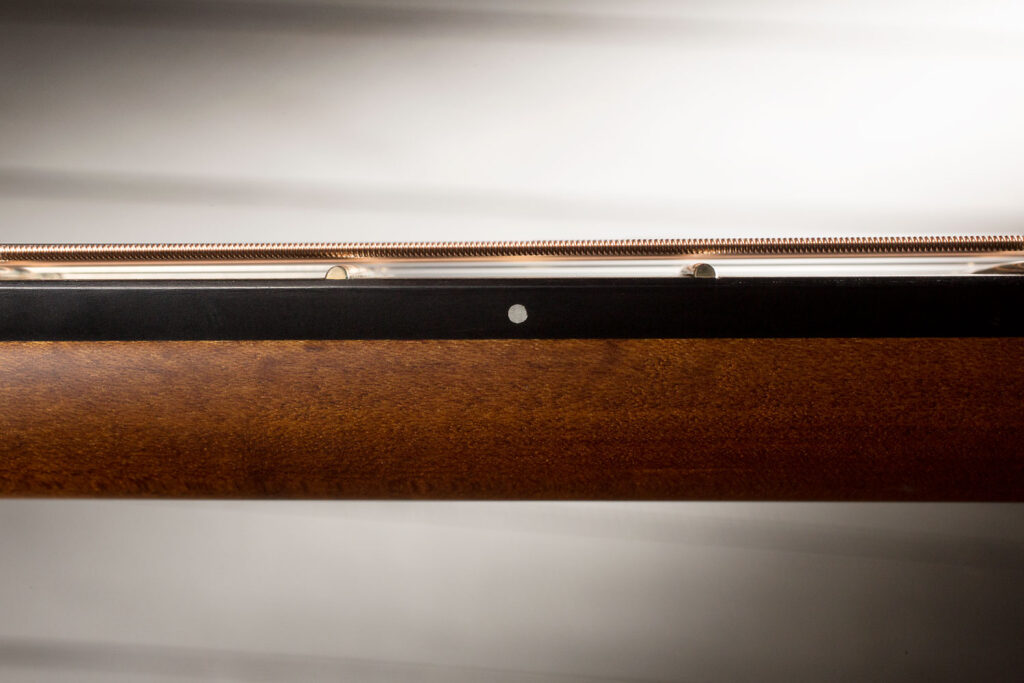
On our acoustic guitars, we use what’s considered a medium-size fret, which fits a broad range of playing styles. The fret wire is a nickel silver alloy with a custom design specification.
The standard action setup for our guitars is low to give people a comfortable playing experience.
“It gives you good dexterity with your fretting hand,” Andy says. “It’s fast, it’s easy to fret cleanly, and it makes it easy to play complicated chord shapes or that F major barre chord.”
A related point that impacts tone, Andy says, is that the distance between the tops of the frets and the bottom of the strings will serve as a limiter for the volume potential. That means if a guitar has higher action, conceivably it can be played harder and produce more volume. The downside is that higher action tends to be harder for the fretting hand to play cleanly.
“It means the action, or string height, is always a balance between how much dynamic range the player needs for the guitar to sound good versus how easy it is to play,” he says.
Taylor Customer Service Manager Glen Wolff says the most common setup request among Taylor owners having their guitars serviced is for the lowest possible action without buzz.
“But that threshold, or balance, between string height and fret buzz is different for every player,” Glen explains. “That’s why it’s often helpful for customers to work with a local certified Taylor service technician, who can see you play in person. It helps with custom setups.”
In terms of how fret size can relate to the playing experience, a higher fret gives the player a slightly more nuanced control over the string.
“You can create vibrato just by changing your finger pressure,” Andy says. “With higher frets you can get sideways on the string to bend it a little easier. That’s typically why we use a bigger fret on an electric guitar, where you’re looking for a little more nuance in your left hand to manipulate the notes you play. We use a bigger fret on the T5z for that reason.”
The downside to taller frets, Glen says, is a player can squeeze the strings out of tune by fretting too hard.
“It takes a little practice to learn to apply just enough pressure to get a clean fretted note from the guitar,” he explains. “This practice will make you a more efficient player and help reduce hand fatigue.”
Fretboard Radius
A guitar’s fretboard radius, or the measure of the curvature across the width of its surface, can vary based on the type of guitar and the specifications of the guitar maker. Traditionally, a classical-style guitar features a completely flat fretboard. The fretboard radius of steel-string and electric guitars can vary significantly. Andy explains the playing benefits of a radius.
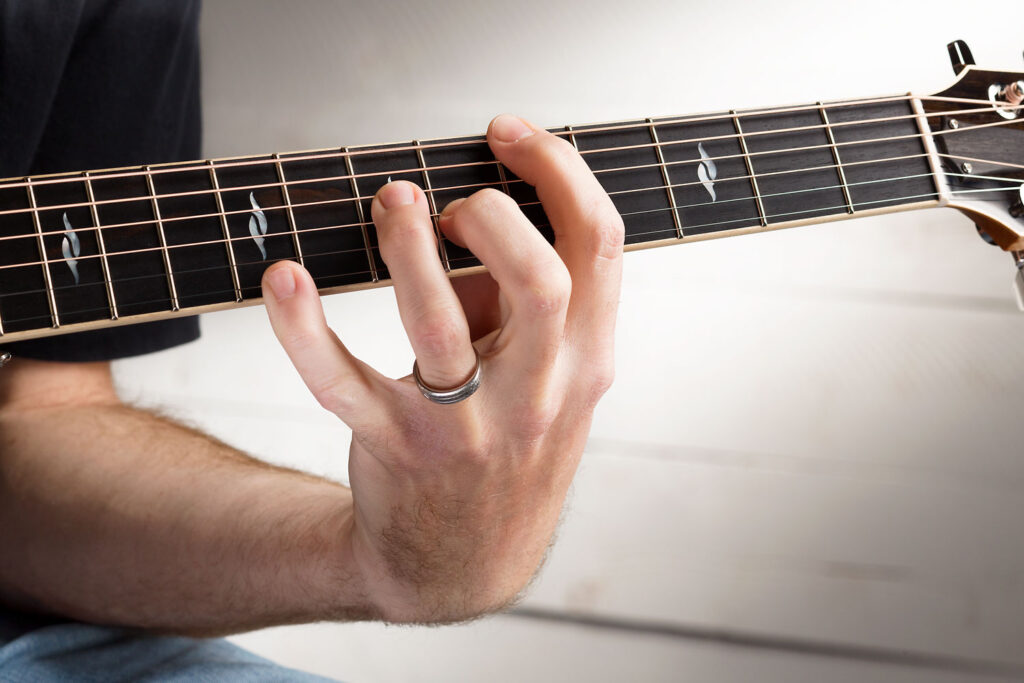
“If you look at your hand, there are no straight lines,” he says. “With a flatter fingerboard you can actually set a little lower string height and bend higher in pitch, or farther, before it runs into the fret in front and chokes itself out. More radius is actually a little easier to play on. If you’re playing complicated chords, barre chords and things like that, your fingers naturally have this curve to them — they don’t want to lay flat. So in order to make it easier to fret the notes cleanly, a little bit of radius to the fingerboard and corresponding string arc pushes the string into your finger a little easier. The simple takeaway is that the more arc you have, the easier it is to fret the notes. If you have a flatter radius, it’s easier to bend strings.”
The 15-inch radius we use on our steel-string acoustic guitar fingerboards lands in the middle of the range across the industry and through guitar history.
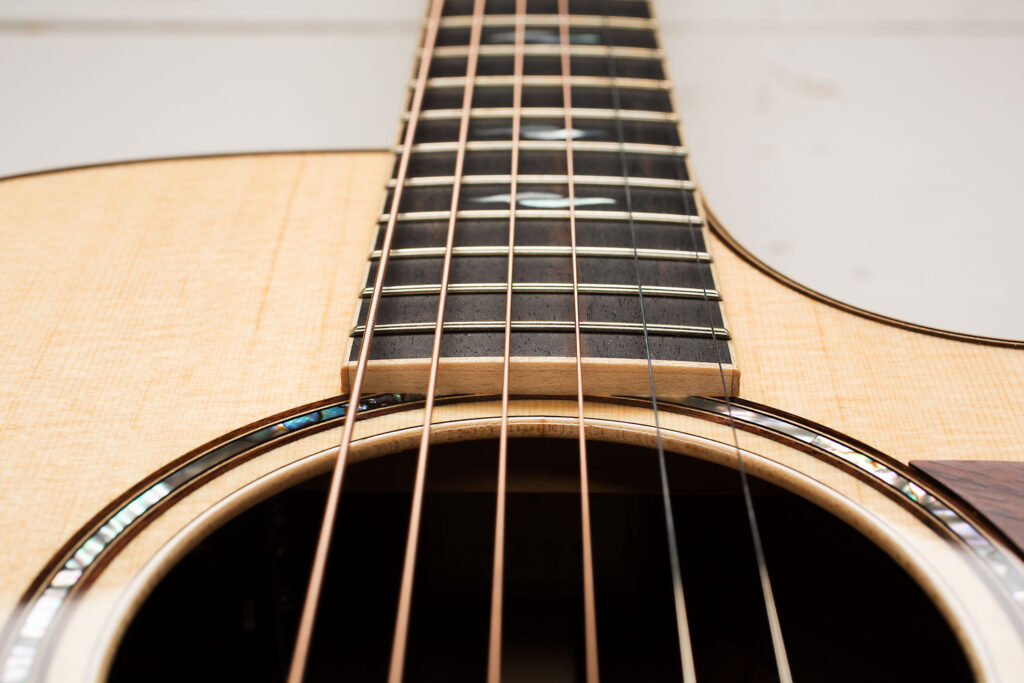
“It’s a happy medium,” Andy says. “It fits a lot of different playing styles comfortably.”
Nylon-string guitars, by contrast, traditionally have a flat fingerboard in part due to the unique variance in string sizes.
“The G and B strings are physically very large diameter, so if you put that over a highly arched fingerboard, it ends up with a very unusual fretting feel — those strings poke you right in the middle of the fingerboard to the extent that it becomes annoying.” Andy says.
Because Taylor’s nylon-string models were designed to be more compatible with the feel of a steel-string guitar to give steel-string players an inviting crossover feel, our nylons feature a 20-inch radius, which is a very small bit of arc.
“Functionally it’s almost flat, but it gives you just enough radius so that someone who’s comfortable on a steel-string guitar feels at home on that instrument,” Andy says.
One of the distinctions between our T5 and T5z models is the fretboard radius. The T5 features a 15-inch radius, while the T5z has a 12-inch radius. Electric guitars typically have more highly arched fingerboards to enhance the fretting hand’s agility. The extra curvature on the T5z, when coupled with jumbo frets, makes it easy to bend strings and to fret, giving the T5z a handfeel that’s closer to that of an electric guitar.
Neck Angle
The neck angle, and specifically Taylor’s patented neck design, controls the geometry between the neck and the body of the guitar. Changing the neck angle has the effect of changing the top’s stiffness and how the strings articulate the top of the guitar. This will impact the playing experience in a few different ways, Andy says.
“It will change the tonal response and volume of the guitar, and it will change the perceived tension on the strings because you’re changing the deflection the top undergoes as soon as the string is plucked. A low neck angle (with the fingerboard more parallel with the top of the guitar) will typically make the strings feel like they’re yielding a little more; they feel slightly slinkier, mostly in the articulating hand. A higher neck angle will tend to focus the sound.”
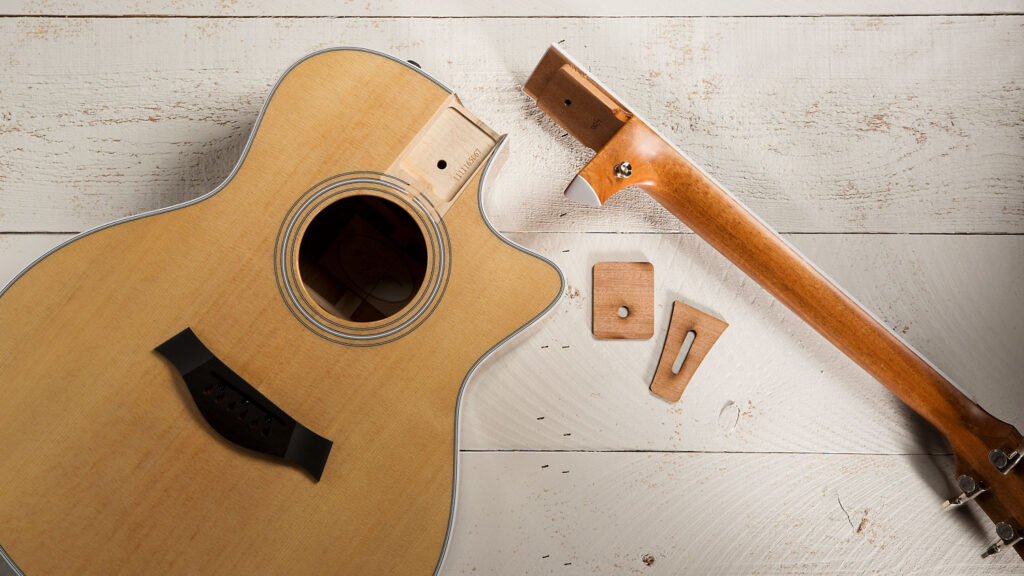
The ability to precisely set and micro-adjust the Taylor neck angle enables the guitar to have the exact geometry we want for an optimized playing experience throughout the entire life of the guitar. This is a huge benefit to the player, in part because a guitar will change over time as it settles in, gets played and acclimates to its environment.
“The angle will change over time,” Andy adds. “The brilliance in the whole design is that 10 years from now, 30 years from now, the player still gets to choose exactly the optimal angle they want.”
Scale Length
A guitar’s scale length refers to the maximum vibrating length of the unfretted open string. It’s typically measured from the nut to the saddle. Changing the scale length changes the tension on the tuned strings, and as a result, both the handfeel and tone. While the scale length can vary on acoustic (and electric) guitars, typically it has to be limited to within about a two-inch window for guitars that will be tuned to concert pitch because of the nature of the vibrational patterns of strings that are set in motion.
“I’ll try not to get too nerdy here,” Andy says. “A vibrating string has two different primary waves: a longitudinal wave that travels back and forth from the saddle to the nut, like water sloshing from one end of a bathtub or pool to another, and a transverse wave that moves in a side-to-side or circular form. Outside a certain scale length range, the two waves tend to interfere with each other and create unusual sounds because the string is basically out of tune with itself.”
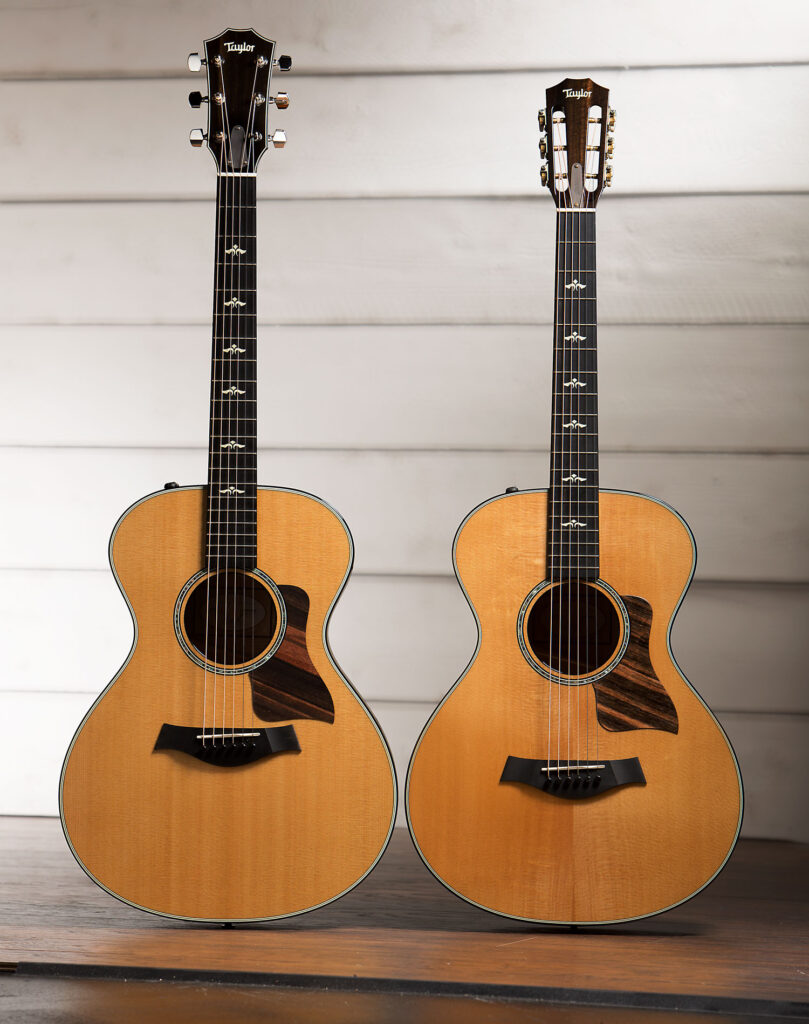
Generally this range for acoustic guitars with typical strings is from about 23-1/2 to 25-1/2 inches. What has been considered standard scale length for full-size Taylor steel-string models is either 24-7/8 or a longer 25-1/2-inch string length — the medium to longer end of this range. Our smaller guitars, like the GS Mini, are designed around the shorter margin of the string length range, at 23-1/2 inches. The Taylor GT has a scale length of 24-1/8 inches. The parameters affecting the tuning of these two waves are the string’s length, tension and weight. If a guitar is designed to be higher or lower in pitch, the other two parameters need to be adjusted to bring the string into harmony with itself. The scale length will change, as will the weight or size of the string. Case in point: Our baritone guitars, which are tuned to B and feature heavier-gauge strings, have a longer 27-inch scale length.
In certain respects, the shorter scale lengths can make the playing experience easier, between of the slinkier handfeel and slightly condensed fret spacing. That’s why it can be an especially appealing choice for players with small hands or less hand strength.
“Often, if somebody is first approaching the guitar, I encourage a shorter scale length for their instrument, because there’s a little less perceived hand pressure, a little less tension, and the space between the frets is a little bit smaller,” Andy says. “It can also be an asset for an advanced player who might be pursuing interesting voicings or complex chord shapes, or where they’ve got unusual reaches. If a fingerstyle player plans to stretch over a long range on a fingerboard to form those back-of-the-book chords, having incrementally smaller fret spacing can really help.”
For guitarists who frequently play in alternate tunings, the longer 25-1/2-inch scale length might be a better choice.
“More often than not, using alternate tunings means tuning down from concert pitch,” Andy explains. “For that reason, I like to use a little longer scale. I prefer a 25-1/2-inch scale if a player is often using tunings like drop D, DADGAD, or similar. The slightly lower pitch, and therefore lower tension, benefits from extra scale length to help keep those notes really clear.”
Neck-to-Body Orientation
The point where an acoustic guitar neck meets the body plays a big role in both the handfeel and tone. Within the Taylor line, the clearest example is the distinction between our 14-fret and 12-fret guitars, offered in separate versions of our Grand Concert in several series. The 14- and 12-fret designations refer to how many frets are clear of the body, which means that since both have the same 24-7/8-inch scale length, the shorter 12-fret design essentially pushes the bridge toward the tail end of the guitar body, closer to the center of the lower bout. The position where the strings are anchored to the top impacts the soundboard movement, and consequently, the tone.
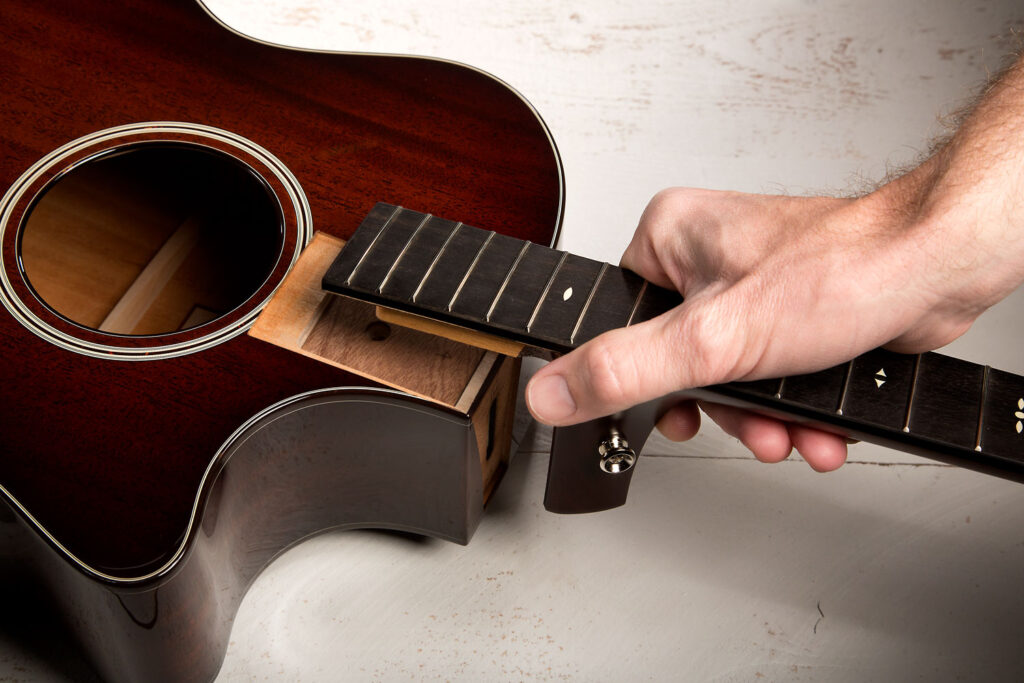
“With the 12-frets you’ll have more midrange swagger,” Andy says. “The guitars have a little more attitude. By moving where the top is articulated from, from closer to the soundhole to a more central location in the lower bout, we get more amplitude out of that top because it’s a more flexible spot. This gives you a little extra warmth and midrange power, with a sleek, slinky handfeel because the top is actually flexing and yielding every time a string is struck, so it effectively reduces that attack tension more immediately.
“When you compare a 14-fret to a 12-fret, the 14-fret will have this chimey, long-sustaining kind of character because the strings are held under a little more solid tension,” Andy adds. “It’s a little more uniform. The 12-fret version will be a bit warmer because the top will allow this flexing to a minute degree more.”
Headstock Type / String Break Angle
Another design variable that plays into handfeel is the use of either a solid or slotted headstock because each impacts the string break angle, and as a result, the string tension, in different ways. Among steel-string models in the Taylor line, we use a slotted headstock specifically for 12-fret models, which Andy says is common among guitar builders who offer a 12-fret.
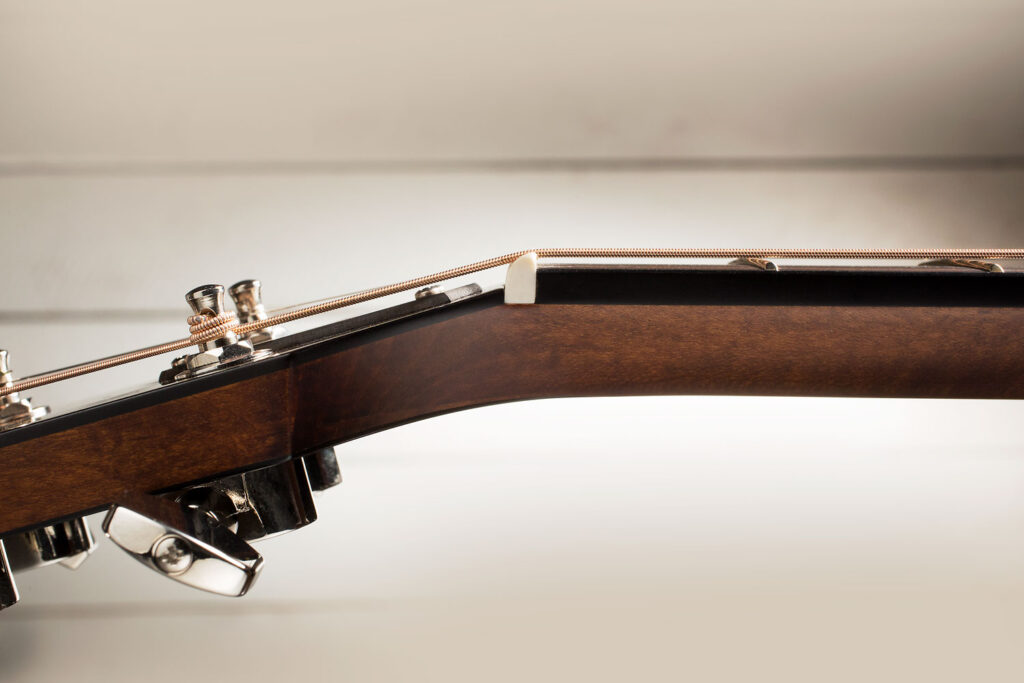
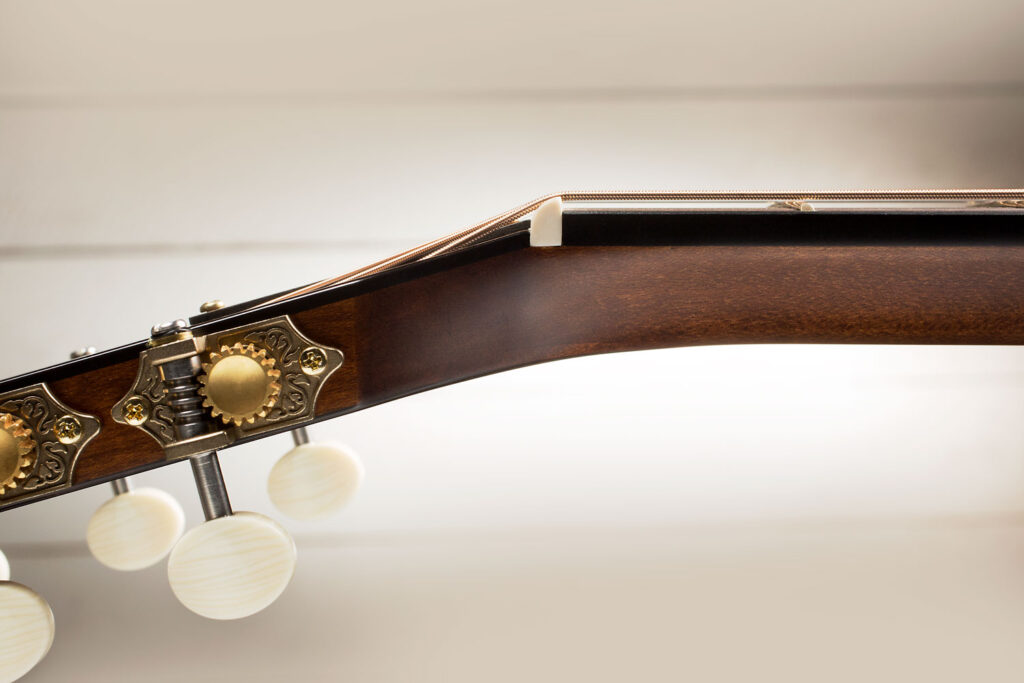
“Typically the preference is for a slotted headstock on a 12-fret neck length because the angle of the strings as they bend over the nut is a little more acute, which puts a little more downward pressure on the nut and changes the flexibility of the lower portion of the strings,” he explains. “So to my fretting hand, it has what feels like a bit more clear tension. It’s a little more precise, a little better behaved. The note doesn’t want to bend quite so easily close to the nut. At the same time, I’m usually combining a slotted headstock with a 12-fret neck and corresponding body design, which creates a slinkier handfeel on the strings because the top wants to move a little more. So you’ll feel a little extra tension close to the nut by your fretting hand, and a little less tension on the articulating hand. They kind of equalize each other, but it’s a different distribution.
“On a 14-fret solid headstock design, these two are reversed. I have a little less downward pressure on the nut, therefore a little less perceived tension in my fretting hand and a little bit more on my articulating hand, closer to the bridge. It’s not a big difference; these are just subtle little things that you can pick up in the tactile qualities of what the strings feel like when your fingertips touch them.”
String Gauge
The size and brand of strings used on a guitar is, not surprisingly, another big contributor to both tone and handfeel. The general rule with steel strings is that the larger the string, the more tension it will have when you tune it to a certain note.
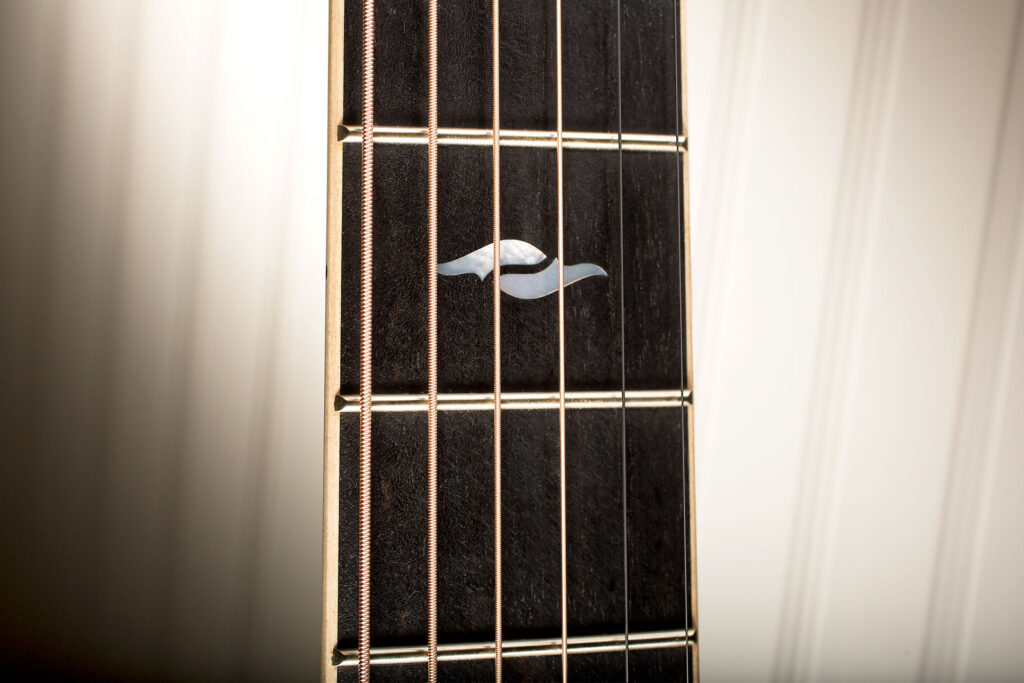
“Most people think of string size only as it relates to tension, but it’s not exclusive,” Andy says. “The tension is controlled by the core wire size. That’s where the strength of the string comes from. You control its weight by what you wrap it with, because the wrapping actually doesn’t have any strength laterally. It just changes its weight. As an industry, we’ve sort of standardized which tensions go through which wraps, but you do see some slight variations from string maker to string maker.”
With string gauges and tension, players often have to take into account the impact on both the tone and feel.
“A little more tension usually translates into a bit more volume and a more robust, clear note at the expense of a little stiffer feel,” he adds. “But it’s not a hard rule. Sometimes you can put so much tension on a guitar that you start to lose volume, so in certain cases a smaller set of strings could actually be louder.”
String Gauge Tips
Here are some basic ideas on the impact of different string gauges on the feel and tone of a guitar, courtesy of Taylor’s Service department:
- Our factory string gauge specifications are listed so people know what we install on a new guitar. That way, if you like the feel and sound, you know what to use.
- Experimenting with different strings is an inexpensive way to customize the sound of your guitar. We encourage that if you’re looking to do so.
- If you’re thinking of switching to lighter strings because your guitar feels difficult to play, consider getting the guitar’s setup checked by a Taylor-certified service technician. Heavier strings with a good setup shouldn’t feel heavy.
- In general, switching to lighter strings comes with a trade-off of slightly reduced richness and volume.
- Changing to a lighter than recommended gauge will not hurt the guitar. Switching to a heavier string is where you have to be careful. Most of our 6-string guitars can handle a set of mediums (.013-.056) tuned to standard pitch. On our 12-strings, don’t use a heavier gauge than what’s recommended (.010-.047) unless you’re tuning down.
A basic rule of thumb is to tune down a half step for every increase in string gauge. This formula can also be applied for people whose guitars are constantly tuned down and who want to know how much heavier a string gauge can safely be used.
Keep in mind that many of the tactile differences explained within these handfeel categories are subtle. But if you use them as a guiding framework to explore and compare different Taylor models based on your playing preferences, you may discover a new “feel” that makes your playing experience more comfortable and expressive than ever.




